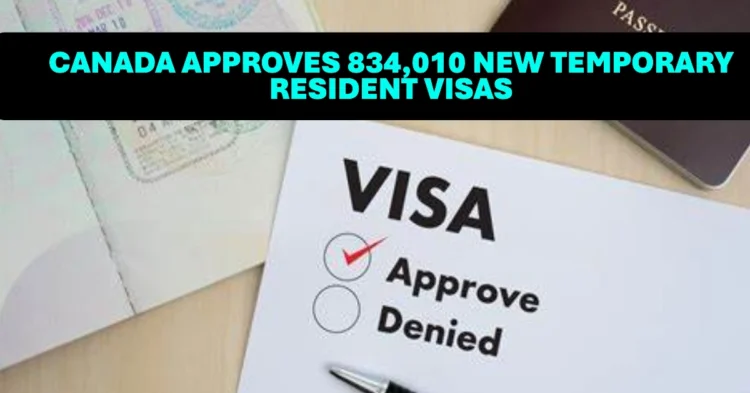Canada welcomed a historic number of temporary residents in the first quarter of 2025. According to data from Immigration, Refugees and Citizenship Canada (IRCC), a staggering 834,010 temporary resident applications and extensions were approved between January and March—spanning international students, temporary foreign workers, and visitors.
While these figures highlight Canada’s commitment to global mobility and talent attraction, they also underscore a pressing paradox: welcoming newcomers while increasing enforcement on current temporary residents. This article unpacks the latest IRCC statistics, key source countries, policy shifts, and the broader social and economic implications of this immigration wave.
Table of Contents
A Breakdown of Canada’s Immigration Surge in Early 2025
From January to March 2025, IRCC processed a total of 1,370,400 temporary resident applications, ultimately approving 834,010. These figures include new applications and extensions across three major categories:
Study Permits
Approved: 96,015
Canada continues to be a top global destination for international students, with approvals granted to individuals studying at Designated Learning Institutions (DLIs). Many of these students are expected to transition to permanent residency through programs such as the Post-Graduation Work Permit Program (PGWPP).
Work Permits
Approved: 186,805
These were primarily issued under the Temporary Foreign Worker Program (TFWP) and the International Mobility Program (IMP), aimed at addressing labor shortages in essential sectors such as healthcare, tech, and agriculture.
Visitor Visas
Approved: 273,990
Visitor visa approvals underscore Canada’s appeal to tourists, business travelers, and family members visiting relatives. These Temporary Resident Visas (TRVs) are particularly relevant for individuals from visa-required countries.
Additionally, the IRCC finalized another 159,200 study permit and 396,000 work permit applications (including extensions), highlighting the immense volume of activity in Canada’s immigration system.
Top Source Countries: Who’s Coming to Canada?
The majority of processed applications originated from diverse global regions, underscoring Canada’s multicultural ethos.
Leading Source Nations (Jan–Mar 2025):
- India: 382,055 applications – Dominated by international students and skilled workers, especially in tech and healthcare.
- Nigeria: 104,835 applications – Driven by students and job seekers in key urban provinces.
- China: 100,890 applications – Focused on study and tourism.
- Mexico: 59,305 applications – Reflects seasonal labor programs and visa-free tourism.
- Iran: 49,735 applications – Largely students and professionals.
- Philippines: 48,430 applications – Notable for caregiving and hospitality roles.
- Ukraine: 33,110 applications – Reflects humanitarian programs post-conflict.
- Pakistan, Colombia, Bangladesh: Each contributing between 27,000–31,000 applications.
This broad representation highlights both economic and humanitarian dimensions of Canada’s immigration priorities.
The Immigration Paradox: Growth Meets Enforcement
Canada’s immigration strategy is not without contradiction. Even as it opens the doors to new applicants, enforcement actions against existing temporary residents are increasing.
Stricter Oversight and Departures
IRCC aims to reduce the share of temporary residents to 5% of Canada’s population by 2026. This involves:
- Enforcing permit expiration and visa violations.
- Implementing a revised February 2025 regulation that empowers immigration officers to cancel permits in cases of fraud, inadmissibility, or overstay.
- Issuing more departure orders to individuals failing to comply with IRPA guidelines.
This dual-track approach—welcoming new arrivals while enforcing removals—has raised concerns among immigration advocates and those affected.
Policy Shifts and Economic Impact
The 2025–2027 Immigration Levels Plan introduced, for the first time, specific targets for temporary residents:
- 2025 Target: 673,650 arrivals
- 2026 Target: 516,600
- 2027 Target: 543,600
These caps exclude short-term tourists and focus instead on work and study permit holders.
Economic Contributions and Strain
- International Students inject billions into the economy through tuition and living expenses.
- Temporary Workers support vital industries facing labor shortages.
- Visitors bolster tourism and retail spending.
However, the surge has also intensified pressure on housing, healthcare, and public infrastructure.
Recent Policy Adjustments
To manage this complexity, IRCC introduced several significant measures:
Study Permit Caps
A 10% reduction from 2024 levels, setting a maximum of 606,250 processed applications.
Post-Graduation Work Permit (PGWP) Reforms
Stricter eligibility linked to labor market demands, prioritizing healthcare, trades, and STEM.
Work Permit Changes
Since January 21, 2025, open work permits for spouses of students and workers have been limited to in-demand occupations.
These policies are designed to stabilize demand on services while aligning immigration with economic priorities.
Challenges and Mixed Reactions
While many stakeholders support a more managed immigration system, the sudden enforcement push has drawn criticism.
Common Concerns:
- Labor Market Gaps: Employers in agriculture, hospitality, and eldercare face acute worker shortages.
- Student Pressures: Higher living costs and tougher language requirements may deter applicants.
- Public Opinion: Mixed views on whether the current balance supports sustainability or undermines Canada’s reputation.
A 2024 IRCC consultation revealed that 44% of respondents felt permanent resident targets were “about right,” while others worried about overcrowding and resource strain.
Supporters argue that prioritizing those already in Canada for permanent residency—over 40% of 2025 PR spots—helps streamline integration and reduce reliance on external recruitment.
Balancing Growth with Sustainability
The approval of over 834,000 temporary residents in just three months reflects both demand and trust in Canada’s immigration system. Yet it also surfaces critical questions about long-term sustainability, housing, and fairness.
Canada is at a crossroads: maintain its welcoming identity or recalibrate to address internal pressures?
For individuals hoping to study, work, or visit Canada, the opportunity remains—but with evolving rules and tighter scrutiny, preparation and awareness are more crucial than ever.

